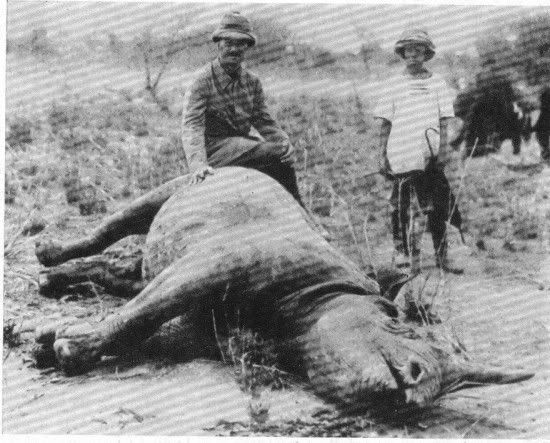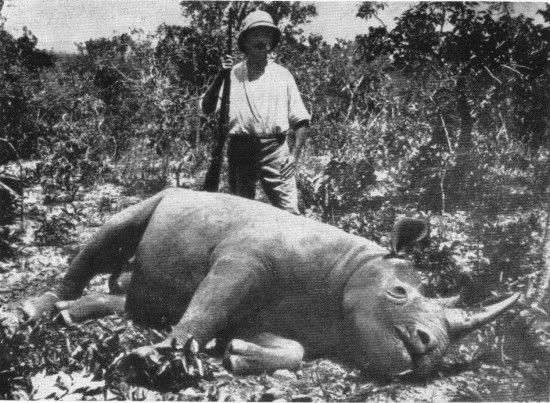|
|
Post by sebbe67 on Nov 4, 2007 23:03:49 GMT
|
|
|
|
Post by sebbe67 on Nov 4, 2007 23:08:01 GMT
 Young male rhinoceros shot by Fritz Holstein near Demssa, north of Gurua in North Cameroon. Illustrated by Zukowsky 1949 in the original description of Diceros bicornis longipes  Black rhino male, shot by Fritz Holstein north of Garua in Northern Cameroon. The photo is undated, possibly ca. 1948 www.rhinoresourcecenter.com |
|
|
|
Post by sebbe67 on Nov 4, 2007 23:16:45 GMT
 Skull of female black rhino. Holotype of Diceros bicornis longipes. The animal was shot by Adolf Friedrich zu Mecklenburg on 9 January 1911 near Mogrum in the Schari area. Museum Senckenberg, Frankfurt am Main, no. 766 (839) A 54 (4440) www.rhinoresourcecenter.com |
|
|
|
Post by another specialist on Nov 5, 2007 19:35:31 GMT
|
|
|
|
Post by another specialist on Nov 5, 2007 19:48:30 GMT
Several lines of action as far as Diceros bicomis taxonomy is concerned seem required by the present analysis. The first is the description, after further thoroughgoing study. of the Luangwa Valley (Zambia) population as a separate subspecies. This would increase the number of subspecies to 8, unless it be deemed unnecessary to maintain D.b. [adoensis, being a clinal variant of the large East Afrfcan subspecies. Skulls from Zululand need to be measured to ascertain precisely what D.b. minor actually is; and skulls from various parts of East. Southeast and Southwest Africa must be compared to both Zululand and Kariba samples to decide just which populations are D.b. minor and which are not. The next analysis, based one hopes on more and larger samples. should leave ungrouped the skulls here lumped as Group 7 (Arusha), as inferentially this sample spanned the border between D.b. michaeli and "minor". Dental characters now appear to vary geographically within the species to a greater extent than was formerly appreciated (Rookmaaker & Groves, 1978). and it may turn out that no East African rhinos are actually D.b. minor. Postcranial skeletons are of significance too: available photographs of D-b. longipes certainly make it look long-legged, but the proposition needs to be tested with actual specimens. The horn character attributed to this subspecies by Zukowsky (1949) was supported on the basis of a single specimen by Groves (1971). and a further specimen seen in the Marseille Museum again has the character [very markedly so, in fact); but this too requires testing on further material. www.rhinoresourcecenter.com/ref_files/1178937328.pdf |
|
|
|
Post by another specialist on Nov 6, 2007 8:28:18 GMT
|
|
|
|
Post by another specialist on Aug 14, 2008 10:54:53 GMT
 Bibliography of the Rhinoceros By L. C. Rookmaaker |
|
|
|
Post by another specialist on Aug 14, 2008 10:58:21 GMT
 African Rhino By Richard Emslie, Martin Brooks |
|
|
|
Post by another specialist on Sept 11, 2008 18:23:25 GMT
|
|
|
|
Post by sebbe67 on Apr 6, 2009 23:00:50 GMT
|
|
|
|
Post by surroundx on Apr 28, 2013 1:01:49 GMT
|
|
|
|
Post by Melanie on May 9, 2013 7:54:05 GMT
|
|
|
|
Post by Sebbe on May 12, 2017 20:33:14 GMT
|
|
|
|
Post by surroundx on Nov 22, 2019 10:39:10 GMT
|
|
|
|
Post by redpinnipedgamer on Nov 11, 2024 0:16:59 GMT
|
|
|
|
Post by Sebbe on Nov 11, 2024 9:41:39 GMT
|
|
|
|
Post by Sebbe on Nov 11, 2024 10:06:41 GMT
|
|